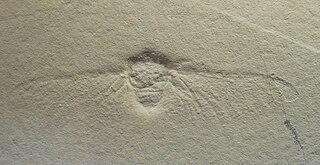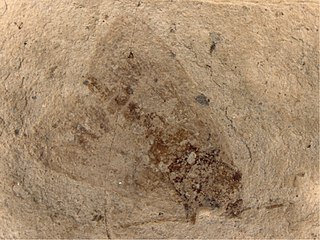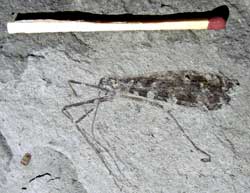Nannochoristidae is a family of scorpionflies with many unusual traits. It is a tiny, relict family of about eight species, with members occurring in New Zealand, southeastern Australia, Tasmania, and Chile. Due to the groups distinctiveness from other scorpionflies, it is sometimes placed in its own order, the Nannomecoptera. The adults look like scorpionflies with more pointed, elongated wings. Most mecopteran larvae are eruciform, or shaped like caterpillars. Nannochoristid larvae, however, are elateriform, or shaped like wireworm or click beetle larvae. They are also the only entirely aquatic Mecoptera. Wing venation suggests a close relationship to dipterans. They are predatory, primarily on the larvae of aquatic Diptera.

Bittacidae is a family of scorpionflies commonly called hangingflies or hanging scorpionflies.

Eomeropidae is a family of aberrant, flattened scorpionflies represented today by only a single living species, Notiothauma reedi, known from the Nothofagus forests in southern Chile, while all other recognized genera in the family are known only as fossils, with the earliest definitive fossil known from Liassic-aged strata, and the youngest from Paleogene-aged strata.
Eoplectreurys is an extinct monotypic genus of spider from the family Plectreuridae, with a sole species, Eoplectreurys gertschi. The fossils of Eoplectreurys were recovered from the ~164 Ma old Middle Jurassic Daohugou formation tuffs in Inner Mongolia, China.
Ororaphidia is an extinct genus of snakefly containing two species: the type species Ororaphidia megalocephala and Ororaphidia bifurcata.

Styporaphidia is a genus of snakefly, belonging to the extinct family Mesoraphidiidae, containing up to two species, the type species Styporaphidia magia and tentatively Styporaphidia? hispanica. The genus was named from the Greek stypos meaning "stem" or "stump" and Raphidia, the type genus for, and most often used as, a stem for generic names in the order Raphidioptera. The species name of S. magia is from the Greek word mageia meaning "magic" while the species name for S.? hispanica is from the Latin Hispania meaning "Spain" in reference to the type locality of the species.
Proraphidia is a genus of snakefly in the extinct family Mesoraphidiidae. The genus currently contains three species; Proraphidia gomezi from the La Pedrera de Rúbies Formation in Spain, Proraphidia hopkinsi from the Weald Clay in England, and the type species Proraphidia turkestanica from Kazakhstan. The genus was first described by O. M. Martynova in 1941 with the publication of P. turkestanica from Jurassic deposits of the Karabastau Formation in Karatau, Kazakhstan.

The Haifanggou Formation is a fossil-bearing rock deposit located near Daohugou village of Ningcheng County, in Inner Mongolia, northeastern China.
Liushusaurus is an extinct genus of lizard described by Susan E. Evans and Yuan Wang in 2010. The genus has a single species, Liushusaurus acanthocaudata, and is known from eight fossils, several of which preserve soft tissue detail. The specimens were found in the Lower Cretaceous aged Yixian Formation of Northeast China. Liushusaurus is one of eight lizards that are known and have been named from the Yixian Formation, part of the diverse Jehol Biota ecosystem.

Mongolarachne is an extinct genus of spiders placed in the monogeneric family Mongolarachnidae. The genus contains only one species, Mongolarachne jurassica, described in 2013, which is presently the largest fossilized spider on record. The type species was originally described as Nephila jurassica and placed in the living genus Nephila which contains the golden silk orb-weavers.

Palaeontinidae, commonly known as giant cicadas, is an extinct family of cicadomorphs. They existed during the Mesozoic era of Europe, Asia, and South America. The family contains around 30 to 40 genera and around a hundred species.

Paleolepidopterites is a collective genus of fossil moths which can not be placed in any defined family. The included species were formerly placed in the leaf-roller family Tortricidae and are known from fossils found in Russia and the United States. The collective genus contains three species: Paleolepidopterites destructus, Paleolepidopterites florissantanus, and Paleolepidopterites sadilenkoi, formerly placed within the genera Tortrix and Tortricites respectively. The three species were formally redescribed and moved to the new collective genus by Heikkilä et al (2018).
Formosibittacus is an extinct genus of hangingfly in the family Bittacidae and containing a single species Formosibittacus macularis. The species is known only from the Middle Jurassic Jiulongshan Formation, part of the Daohugou Beds, near the village of Daohugou in Ningcheng County, northeastern China.
Jurahylobittacus is an extinct genus of hangingfly in the family Bittacidae and containing a single species Jurahylobittacus astictus. The species is known only from the Middle Jurassic Jiulongshan Formation, part of the Daohugou Beds, near the village of Daohugou in Ningcheng County, northeastern China.

Juracimbrophlebia is an extinct genus of hangingflies that lived during the Middle Jurassic Period about 165 million years ago, containing only its type species, Juracimbrophlebia ginkgofolia; it was discovered in deposits from Daohugou in northeastern China’s Inner Mongolia.

Miriholcorpa is an extinct genus of scorpionfly (Mecoptera) from the Middle Jurassic period of China. The type and only species is M. forcipata, described in 2013.

Fortiholcorpa paradoxa is an extinct species of scorpionfly (Mecoptera) from the Middle Jurassic of China. It is the only known species of its genus.

Jurassipanorpa is a genus of fossil scorpionfly containing two species described in 2014 from the Jiulongshan Formation of Inner Mongolia, China. The two species, J. impuctata and J. sticta, lived in the late Middle Jurassic period and represent the oldest known representatives of the scorpionfly family Panorpidae.
Holcorpa is a genus of extinct insects in the scorpionfly order Mecoptera. Two Eocene age species found in Western North America were placed into the genus, H. dillhoffi and H. maculosa.

Cimbrophlebiidae is an extinct family of scorpionflies. They are considered to be the sister group to the Bittacidae, together forming the clade Raptipedia.











